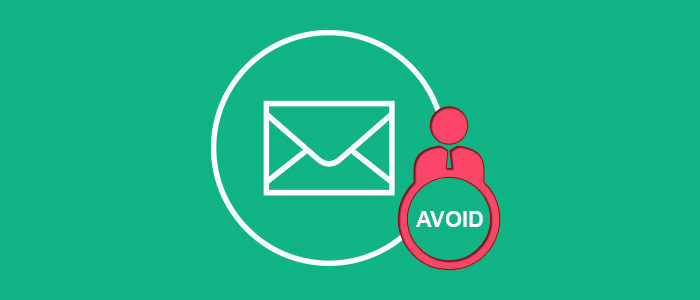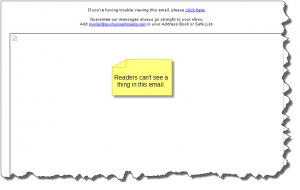In the quest to increase sales and traffic to the website or simply generate awareness of product/service, companies are implementing Email marketing.
Email marketing is one of the simplest and most effective forms of one-to-one communication. To get the most from your email campaigns, here’s a list of things that you should avoid in Email marketing.
1. T00 MUCH PUNCTU@TION** ??? !!!
-
- Don’t use all capital letters
- Don’t use repetitive symbols, such as strings of dollar signs
- It’s a definite bad practice to use strings of asterisks before and after headlines
- Avoid multiple exclamation points or question marks
2. Not welcoming your subscribers
The first email you send to a new subscriber is also the first step in building a relationship with your subscriber. When that initial interaction is positive, subscribers will be more receptive to your future emails. Also, a welcome email is also an excellent opportunity to make a sale.
According to research, welcome emails have higher open rates and click-through rates than standard marketing emails.
If you are not sending a welcome email, then you are losing out not only an opportunity of building a trust-worthy relationship with your subscriber but also a chance to land a sale!

3. Forgetting a call-to-action
Call-to-action or CTA helps to put the right message in front of your subscriber at the right time. It helps to trigger the expected response from your subscribers.
Your CTAs have a direct impact on your conversions. CTA button consists of two elements- design and text.
CTA design is a visual cue that helps to attract the prospect’s attention to the CTA. In other words, CTA design answers the question, “Where should I click?”
Button text, on the other hand, helps prospects make up their minds in the last critical moment and answers the question, “Why should I click this button?”
There is no “ultimate CTA” that works every time. CTAs come in all sizes, shapes, and colors, and there really is no one-size-fits-all solution that works every time. It all depends on the context and the layout of your email.
4. Generic or unfamiliar From Address
Readers don’t know and can’t connect with Customer Care customercare@online.yourcompay.com. Use your brand name or name that users recognize. Keep in mind that you are building a relationship with your customers. How would you like them to see you?
Also, it comes across as uncaring to subscribers. When you ask your visitors to subscribe to your newsletter or your company updates, you should always have a two-way conversation, wherein you send your latest updates, blogs, etc. and your subscribers reply to your email with their feedback, views or suggestions. By doing this you make sure, that your subscriber finds your emails useful and engaging.
5. Difficult unsubscribe process
There is nothing more annoying to your readers than to have a very difficult unsubscribe process. Especially instances where you need the reader to login to his or her account before opting out.
Emails are not read. They are scanned. It’s always a good practice clearly indicate a process for the readers to unsubscribe. If you don’t, over a period of time unread emails will only land in the junk folder, or worse, your readers could hit the “this is spam” button. Both these actions could affect your IP reputation badly.
A clear and quick unsubscribe process is a must.
6. Using the whole email as an image
We see many many big and small companies do this. This is is a BIG NO NO. Images are turned off by default in most email clients. By giving a whole image in your email you are asking the person to click the image before they even read the content. Predictably most users ignore such emails. This is a lost opportunity.
7. Boring Subject Lines
Subject lines should prompt your audience to open your email, not simply provide a name for the email. For example, an email with a Subject line that reads, ‘June Newsletter’ isn’t likely to generate too much excitement. Try the following ideas to keep your subject lines from boring your audience:
- Include the immediate benefits of opening your email in the Subject line.
- Use your Subject line to highlight one of the articles in your email.
- Repeat your email’s main call to action in your subject line.
- Repeat one of your email’s main headlines in your Subject line.
8. Sending too many emails
Email frequency is the thin line between being helpful and annoying, timely and spammy, converting and unsubscribed. You need to maintain a balance between this in order to create a successful email strategy. 69% of people unsubscribe from your emails is because they are tired of receiving emails from you.
One of the ways out can be to let your subscribers control the frequency of your emails. Let them decide if they want to receive daily, weekly or monthly updates from you.
9. Not segmenting subscribers
Sending out a bulk email to your subscribers, annoys them, because they may not be looking for the stuff that you are sending. It may be completely irrelevant to them. This is again one more reason why a subscriber might end up unsubscribing from your emails.
So make sure you segment your email lists. Wait! What is the list segmentation? Email marketing segmentation is the act of splitting your list into different groups or segments that consist of people with similar characteristics.
So segmenting helps you to share personalized content at the right time with the right people.
10. Neglecting mobile users
According to a survey, nearly 68% of all emails are opened on a mobile device, and 52% of those are on smartphones; which is why you should never ignore the impact of a responsive email design.
Responsive emails automatically adapt to whatever device they are opened upon. In other words, emails with a responsive design look great on every device – no matter what kind is used.


